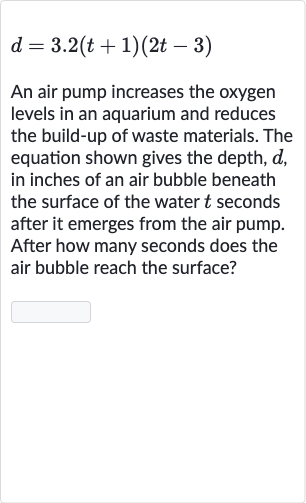AI tutor
Welcome to Bytelearn!
Let’s check out your problem:

An air pump increases the oxygen levels in an aquarium and reduces the build-up of waste materials. The equation shown gives the depth, , in inches of an air bubble beneath the surface of the water seconds after it emerges from the air pump. After how many seconds does the air bubble reach the surface?
Full solution
Q. An air pump increases the oxygen levels in an aquarium and reduces the build-up of waste materials. The equation shown gives the depth, , in inches of an air bubble beneath the surface of the water seconds after it emerges from the air pump. After how many seconds does the air bubble reach the surface?
- Understand the Problem: Understand the problem.We are given an equation that represents the depth of an air bubble in an aquarium as a function of time . We need to find out when the air bubble reaches the surface. The surface is represented by a depth of inches.
- Set Depth to : Set the depth to to find when the bubble reaches the surface.We need to solve the equation for .
- Factor Out Constant: Factor out the constant . Since is a constant multiplier, we can divide both sides of the equation by to simplify our equation. This gives us .
- Apply Zero Product Property: Apply the zero product property.The zero product property states that if a product of two factors is zero, then at least one of the factors must be zero. Therefore, we set each factor equal to zero: and .
- Solve First Factor: Solve the first factor for . Solving for gives us .
- Solve Second Factor: Solve the second factor for . Solving for gives us , which simplifies to or .
- Evaluate Solutions: Evaluate the solutions.The solution does not make sense in this context because time cannot be negative. Therefore, we discard this solution. The solution seconds is the time when the air bubble reaches the surface.
More problems from Write exponential functions: word problems
QuestionGet tutor help
QuestionGet tutor help
QuestionGet tutor help
QuestionGet tutor help
QuestionGet tutor help
QuestionGet tutor help
QuestionGet tutor help
QuestionGet tutor help
QuestionGet tutor help
